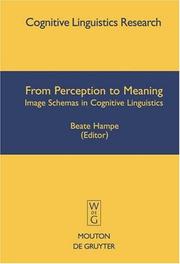| Listing 1 - 10 of 10 |
Sort by
|
Book
ISSN: 15667774 ISBN: 9789027239006 9027239002 9786612105708 1282105701 9027291012 9789027291011 Year: 2008 Volume: 12 Publisher: Philadelphia : John Benjamins,
Abstract | Keywords | Export | Availability | Bookmark
 Loading...
Loading...Choose an application
- Reference Manager
- EndNote
- RefWorks (Direct export to RefWorks)
The cognitive and language sciences are increasingly oriented towards the social dimension of human cognition and communication. The hitherto dominant approach in modern cognitive science has viewed "social cognition" through the prism of the traditional philosophical puzzle of how individuals solve the problem of understanding Other Minds. The Shared Mind challenges the conventional "theory of mind" approach, proposing that the human mind is fundamentally based on intersubjectivity: the sharing of affective, conative, intentional and cognitive states and processes between a plur
Intersubjectivity --- Language and languages --- Communication --- Evolution --- Communication. --- Evolution. --- Intersubjectivity. --- Language and languages. --- Philosophical anthropology --- Psycholinguistics --- Sociolinguistics --- #KVHA:Taalkunde --- #KVHA:Cognitieve linguïstiek --- #KVHA:Intersubjectiviteit --- Intersubjectivité --- Psycholinguistique --- Psychological aspects --- Aspect psychologique --- Foreign languages --- Languages --- Anthropology --- Ethnology --- Information theory --- Meaning (Psychology) --- Philology --- Linguistics --- Ontology --- Phenomenology --- Social psychology --- Subjectivity --- Philosophy --- Creation --- Emergence (Philosophy) --- Teleology --- Communication, Primitive --- Mass communication --- Sociology
Book
Year: 1997 Publisher: Stockholm Gotab
Abstract | Keywords | Export | Availability | Bookmark
 Loading...
Loading...Choose an application
- Reference Manager
- EndNote
- RefWorks (Direct export to RefWorks)

ISBN: 9783110193275 9783110196184 Year: 2007 Publisher: Berlin Mouton de Gruyter
Abstract | Keywords | Export | Availability | Bookmark
 Loading...
Loading...Choose an application
- Reference Manager
- EndNote
- RefWorks (Direct export to RefWorks)
Language and languages --- Mind and body --- Semiotics --- Semeiotics --- Semiology (Linguistics) --- Semantics --- Signs and symbols --- Structuralism (Literary analysis) --- Body and mind --- Body and soul (Philosophy) --- Human body --- Mind --- Mind-body connection --- Mind-body relations --- Mind-cure --- Somatopsychics --- Brain --- Dualism --- Philosophical anthropology --- Holistic medicine --- Mental healing --- Parousia (Philosophy) --- Phrenology --- Psychophysiology --- Self --- Philosophy --- Psychological aspects --- Sociolinguistics --- Psycholinguistics
Book
Year: 2007 Publisher: Berlin Mouton De Gruyter
Abstract | Keywords | Export | Availability | Bookmark
 Loading...
Loading...Choose an application
- Reference Manager
- EndNote
- RefWorks (Direct export to RefWorks)
Book
ISBN: 9789027241566 9789027274915 9027241562 Year: 2012 Volume: 6 Publisher: Amsterdam: Benjamins,
Abstract | Keywords | Export | Availability | Bookmark
 Loading...
Loading...Choose an application
- Reference Manager
- EndNote
- RefWorks (Direct export to RefWorks)
The close relationship between motion (bodily movement) and emotion (feelings) is not an etymological coincidence. While moving ourselves, we move others; in observing others move – we are moved ourselves. The fundamentally interpersonal nature of mind and language has recently received due attention, but the key role of (e)motion in this context has remained something of a blind spot. The present book rectifies this gap by gathering contributions from leading philosophers, psychologists and linguists working in the area. Framed by an introducing prologue and a summarizing epilogue (written by Colwyn Trevarthen, who brought the phenomenological notion of intersubjectivity to a wider audience some 30 years ago) the volume elaborates a dynamical, active view of emotion, along with an affect-laden view of motion – and explores their significance for consciousness, intersubjectivity, and language. As such, it contributes to the emerging interdisciplinary field of mind science, transcending hitherto dominant computationalist and cognitivist approaches.
lichaamstaal --- Psycholinguistics --- expressed emotion --- Affective and dynamic functions --- Motion in language --- Language and emotions --- Langage --- --Émotion --- --Mouvement --- --Métaphore --- --Motion in language. --- Language and emotions. --- #KVHA:Taalkunde --- #KVHA:Discourse analysis --- #KVHA:Emotie --- Motion in language. --- --#KVHA:Taalkunde --- Émotion --- Mouvement --- Métaphore
Digital

ISBN: 9783110197150 9783110173710 Year: 2008 Publisher: Berlin ;; Boston De Gruyter Mouton
Abstract | Keywords | Export | Availability | Bookmark
 Loading...
Loading...Choose an application
- Reference Manager
- EndNote
- RefWorks (Direct export to RefWorks)


ISBN: 9783110207507 9783110193275 Year: 2008 Publisher: Berlin ;; Boston De Gruyter Mouton
Abstract | Keywords | Export | Availability | Bookmark
 Loading...
Loading...Choose an application
- Reference Manager
- EndNote
- RefWorks (Direct export to RefWorks)


ISBN: 9783110197532 9783110183115 Year: 2008 Publisher: Berlin ;; Boston De Gruyter Mouton
Abstract | Keywords | Export | Availability | Bookmark
 Loading...
Loading...Choose an application
- Reference Manager
- EndNote
- RefWorks (Direct export to RefWorks)
Digital

ISBN: 9783110219074 9783110177091 Year: 2009 Publisher: Berlin ;; Boston De Gruyter Mouton
Abstract | Keywords | Export | Availability | Bookmark
 Loading...
Loading...Choose an application
- Reference Manager
- EndNote
- RefWorks (Direct export to RefWorks)
Digital

ISBN: 9783110261318 9783110209624 Year: 2013 Publisher: Berlin ;; Boston De Gruyter Mouton
Abstract | Keywords | Export | Availability | Bookmark
 Loading...
Loading...Choose an application
- Reference Manager
- EndNote
- RefWorks (Direct export to RefWorks)
| Listing 1 - 10 of 10 |
Sort by
|

 Search
Search Feedback
Feedback About UniCat
About UniCat  Help
Help News
News